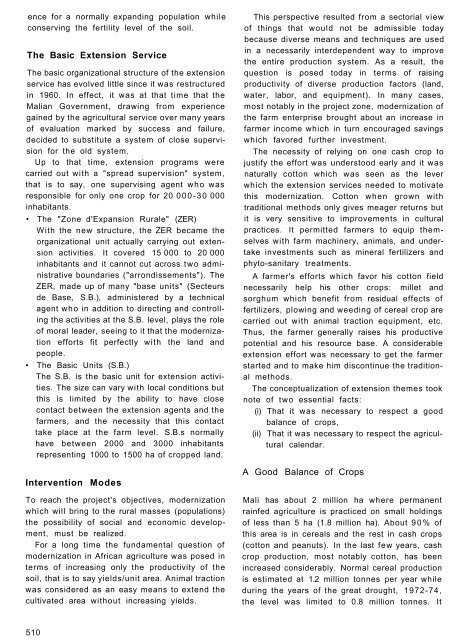RA 00048.pdf - OAR@ICRISAT
RA 00048.pdf - OAR@ICRISAT
RA 00048.pdf - OAR@ICRISAT
You also want an ePaper? Increase the reach of your titles
YUMPU automatically turns print PDFs into web optimized ePapers that Google loves.
ence for a normally expanding population while<br />
conserving the fertility level of the soil.<br />
The Basic Extension Service<br />
The basic organizational structure of the extension<br />
service has evolved little since it was restructured<br />
in 1960. In effect, it was at that time that the<br />
Malian Government, drawing from experience<br />
gained by the agricultural service over many years<br />
of evaluation marked by success and failure,<br />
decided to substitute a system of close supervision<br />
for the old system.<br />
Up to that time, extension programs were<br />
carried out with a "spread supervision" system,<br />
that is to say, one supervising agent who was<br />
responsible for only one crop for 20 000-30 000<br />
inhabitants.<br />
• The "Zone d'Expansion Rurale" (ZER)<br />
With the new structure, the ZER became the<br />
organizational unit actually carrying out extension<br />
activities. It covered 15 000 to 20 000<br />
inhabitants and it cannot cut across two administrative<br />
boundaries ("arrondissements"). The<br />
ZER, made up of many "base units" (Secteurs<br />
de Base, S.B.), administered by a technical<br />
agent who in addition to directing and controlling<br />
the activities at the S.B. level, plays the role<br />
of moral leader, seeing to it that the modernization<br />
efforts fit perfectly with the land and<br />
people.<br />
• The Basic Units (S.B.)<br />
The S.B. is the basic unit for extension activities.<br />
The size can vary with local conditions but<br />
this is limited by the ability to have close<br />
contact between the extension agents and the<br />
farmers, and the necessity that this contact<br />
take place at the farm level. S.B.s normally<br />
have between 2000 and 3000 inhabitants<br />
representing 1000 to 1500 ha of cropped land.<br />
Intervention Modes<br />
To reach the project's objectives, modernization<br />
which will bring to the rural masses (populations)<br />
the possibility of social and economic development,<br />
must be realized.<br />
For a long time the fundamental question of<br />
modernization in African agriculture was posed in<br />
terms of increasing only the productivity of the<br />
soil, that is to say yields/unit area. Animal traction<br />
was considered as an easy means to extend the<br />
cultivated area without increasing yields.<br />
This perspective resulted from a sectorial view<br />
of things that would not be admissible today<br />
because diverse means and techniques are used<br />
in a necessarily interdependent way to improve<br />
the entire production system. As a result, the<br />
question is posed today in terms of raising<br />
productivity of diverse production factors (land,<br />
water, labor, and equipment). In many cases,<br />
most notably in the project zone, modernization of<br />
the farm enterprise brought about an increase in<br />
farmer income which in turn encouraged savings<br />
which favored further investment.<br />
The necessity of relying on one cash crop to<br />
justify the effort was understood early and it was<br />
naturally cotton which was seen as the lever<br />
which the extension services needed to motivate<br />
this modernization. Cotton when grown with<br />
traditional methods only gives meager returns but<br />
it is very sensitive to improvements in cultural<br />
practices. It permitted farmers to equip themselves<br />
with farm machinery, animals, and undertake<br />
investments such as mineral fertilizers and<br />
phyto-sanitary treatments.<br />
A farmer's efforts which favor his cotton field<br />
necessarily help his other crops: millet and<br />
sorghum which benefit from residual effects of<br />
fertilizers, plowing and weeding of cereal crop are<br />
carried out with animal traction equipment, etc.<br />
Thus, the farmer generally raises his productive<br />
potential and his resource base. A considerable<br />
extension effort was necessary to get the farmer<br />
started and to make him discontinue the traditional<br />
methods.<br />
The conceptualization of extension themes took<br />
note of two essential facts:<br />
(i) That it was necessary to respect a good<br />
balance of crops,<br />
(ii) That it was necessary to respect the agricultural<br />
calendar.<br />
A Good Balance of Crops<br />
Mali has about 2 million ha where permanent<br />
rainfed agriculture is practiced on small holdings<br />
of less than 5 ha (1.8 million ha). About 9 0 % of<br />
this area is in cereals and the rest in cash crops<br />
(cotton and peanuts). In the last few years, cash<br />
crop production, most notably cotton, has been<br />
increased considerably. Normal cereal production<br />
is estimated at 1.2 million tonnes per year while<br />
during the years of the great drought, 1972-74,<br />
the level was limited to 0.8 million tonnes. It<br />
510

















